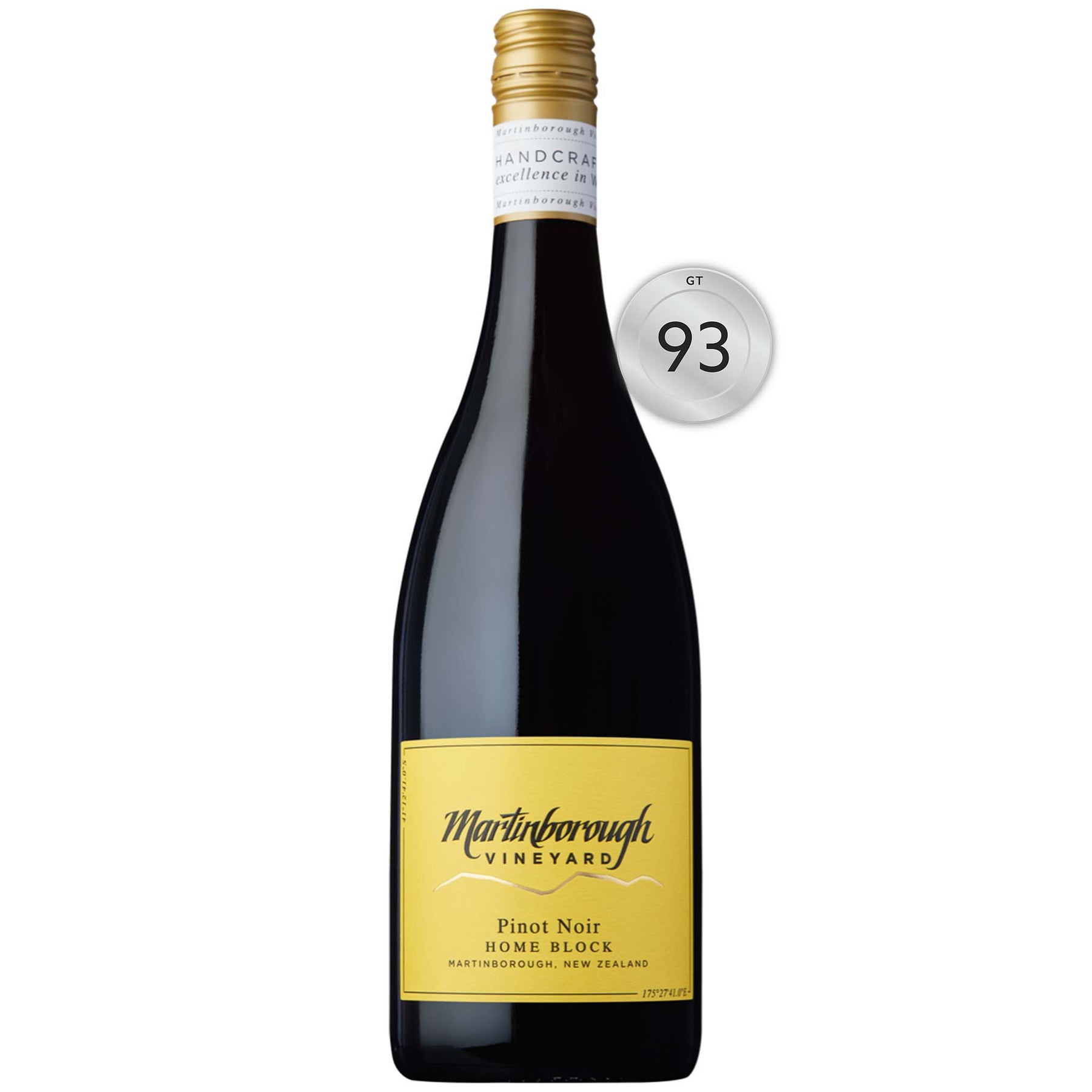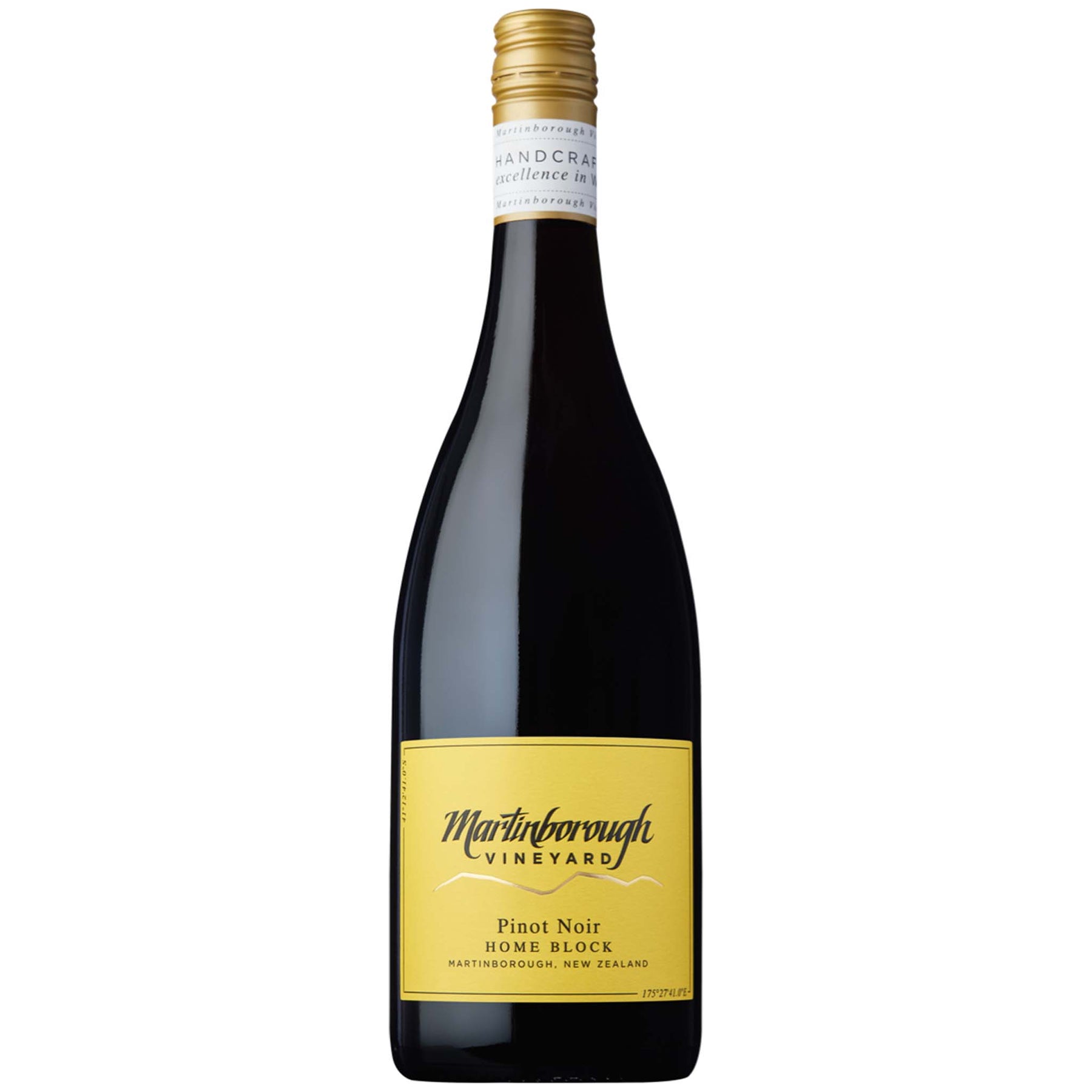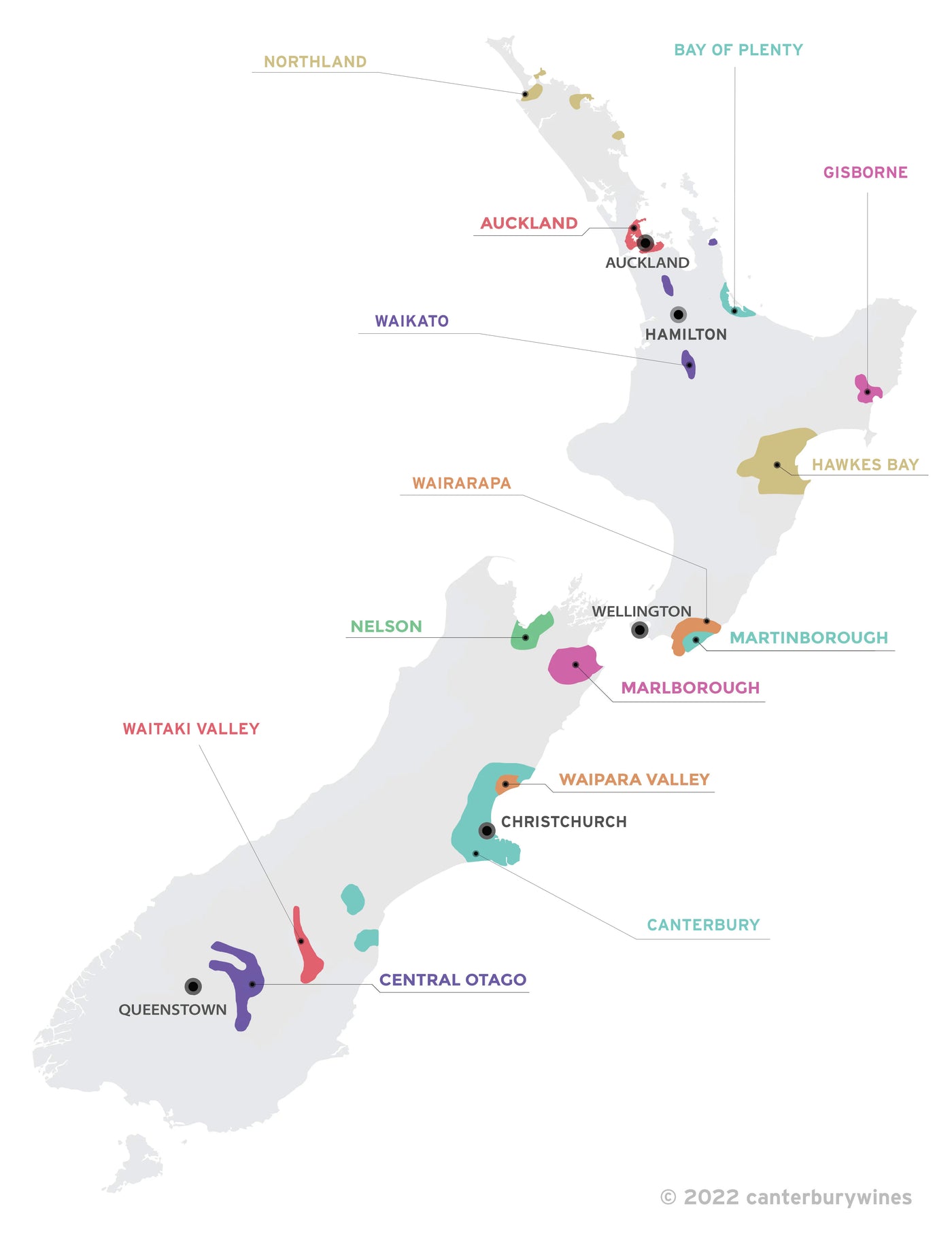

Martinborough Vineyard Home Block Pinot Noir 2018
Style: Red Wine
Closure: Screwcap
Martinborough Vineyard Home Block Pinot Noir 2018
Warehouse
34 Redland Drive
Vermont VIC 3133
Australia
Producer: Martinborough Vineyard
Country: New Zealand
Region: Martinborough
Vintage: 2018
Critic Score: 97
Alcohol: 13.5%
Size: 750 ml
Drink by: 2035
Martinborough Vineyard is a small, family-owned winery in the Martinborough region with a big reputation for pinot noir. The Home Block label is their flagship Pinot Noir.
"Forest-floor complexity lifted by estery fragrance. The palate is beautifully balanced, combining sweet, red cherry flavours and fine tannins. Subtle spice adds interest. A juicy, generous pinot." Gourmet Traveller Wine
Expert reviews
"The 2018 Martinborough Vineyard Home Block Pinot Noir (NZ$75) is starting to show development, with forest-floor complexity lifted by estery fragrance. The palate is beautifully balanced, combining sweet, red cherry flavours and fine tannins. Nice length, too. Paterson found, 'Aromatic red fruits with hints of tomato leaf and rhubarb. The palate has juicy cherry fruit on the mid palate with appropriate acid and integrated tannin. Subtle spice adds interest. A juicy, generous pinot'." Gourmet Traveller Wine, NZ Pinot Noir Tasting - 93 points
About martinborough
 Martinborough is one of the three sub-regions of the Wairarapa wine region in the southern part of New Zealand's North Island. It is world renowned and by far the most important sub-region (the other two being Gadstone and Masterton), so is considered here to be a region to avoid confusion.
Martinborough is one of the three sub-regions of the Wairarapa wine region in the southern part of New Zealand's North Island. It is world renowned and by far the most important sub-region (the other two being Gadstone and Masterton), so is considered here to be a region to avoid confusion.
The small, picturesque town of Martinborough and its surrounding district are home to some of New Zealand's most highly respected boutique wineries. Martinborough lies in a wide river valley between the Rimutaka mountain range and the eastern Wairarapa hills. The Ruamahanga River meanders through the region on its way to Palliser Bay, 32 kilometers to the south. The first vines were planted here by James Busby in 1838 when he was sent from England to collect samples of all grape varieties for potential introduction into Australia (he found that European vines did not grow well in Australia, but thrived in New Zealand's climate conditions). However, it was not until the 1970s that it was discovered as a prime site for viticulture. In 1978, a scientific report compared the climate of the region with that of Burgundy in France, and a few pioneering vignerons began to buy land around Martinborough and plant it with vines.
The viticultural focal point of the region is the Martinborough Terrace – a raised plateau of alluvial gravel just north of the town that has been forced up over time by tectonic movement. The free-draining nature of this soil is excellent for viticulture because it limits the hydration of the vines, leading to stress. These stressed vines put their energy more into producing small, concentrated berries than leafy foliage, increasing the quality of the grapes and subsequently the wines. Similar soils extend around this small area, notably further east, in the unoffical Te Muna sub-region. Vineyards can also be found further south of Martinborough although this region tends to be cooler with a more mixed soil makeup, often with slightly higher levels of clay.
Despite the fact that Martinborough has only three percent of all of New Zealand's vineyard land, it is still widely considered to be one of the country's prime wine regions. Its claim to fame is the exceptional quality of its Pinot Noir wines, produced by some of the most highly regarded wineries in New Zealand.
"Martinborough's reputation for producing high quality pinot has been known for almost as long as the region's existence, but it's a reputation that has seen extraordinary growth in recent times. 'When I came here in 1986 there were only four wine producers,' says McKenna, who to many is recognised as one of the region's father figures. 'Three of them are amongst the best that are still here', referring to Martinborough Vineyard, Ata Rangi and Dry River. 'It's fair to say,' he continues, 'that the combination of vine age and producers' experience with the district has certainly equated to a gradual increase in quality.' The pursuit of excellence is always top of mind, to which Ata Rangi winemaker Helen Masters attests. 'If I need something done, there's no question about cost, time, effort,' she says. 'We just make it happen.' The irony, as any visitor to the region is bound to hear, is that Martinborough contributes just one percent of New Zealand's annual grape crush but is home to 10 percent of the country's winemakers. If that's not saying something about the quality of the wine, what is?
The wines here are centered on a few key varieties, but unlike many other regions, are almost impossible to pigeonhole. Everything from the flat, free-draining gravel vineyards of the Martinborough terrace to the denser stony clay soils of Te Muna Road, the heavy focus on terroir, vintage, or clonal selection, or all of the above, results in a wealth of wine styles that share the common ground of elegance and richness and speak loudly of time and place.
Pinot noir is by far the region's hero – which typically, thanks to the region's climatic similarities to Burgundy, produces beautiful medium-bodied wines with dark plum fruit flavours and distinct savoury characters – followed closely by luscious pinot gris and mineral-like sauvignon blanc, as well as chardonnay, riesling, gewürztraminer and syrah.
The township was established in the late 1870s by John Martin, an Irish landowner whose patriotism for home remains evident in the Union Jack-shaped town square. However, the region's modern wine industry wasn't established until a century later after soil scientist Dr Derek Milne conducted a report that yielded the resemblance-to-Burgundy results. He subsequently founded Martinborough Vineyard; others soon followed suit and those four or five founding producers spawned a progressive farming community that lives and breathes the 'wine is made in the vineyard' philosophy. It's a special place." Dom Sweeney, Gourmet Traveller Wine
About the winery

Established in 1980 by six wine enthusiasts, Martinborough Vineyard is an iconic, pioneering producer of Martinborough with a commitment to the perfection of Pinot Noir. The first winery to plant Pinot Noir grapes in the famed region, today it is home to the oldest vines in the district.
20,000 years ago the ancient Ruamahanga River flowed, carving out dramatic cliffs and forming alluvial river terraces. Silty loam was cast across the landscape over free-draining gravels. These ancient soils contribute to the ideal grape growing conditions and low vigour vineyards which produce greater fruit intensity.
The first commercial vintage was 1984 and the founders soon realized they needed to appoint a well-qualified winemaker to allow the special qualities of the site to be realized. Larry McKenna became the first winemaker and helped establish Martinborough Vineyards as a premium wine estate. Today winemaking is carried out by Paul Mason.
A philosophy of sustainable viticulture, low yields and minimal intervention winemaking allows the wines to speak of their site. Artisan winemaking techniques, along with dedication to land preservation, and sharing a legacy of wine knowledge with future generations, has earned Martinborough Vineyard a continuous reputation for excellence.
Martinborough Vineyards are low cropped and hand-tended, yielding approximately 300 tonnes of fruit annually and exclusively grown in the Martinborough appellation using a biological farming method. This method promotes healthy soils which in turn produce healthy vines, more resistant to disease and insects.

New Zealand
New Zealand is home to more than 700 wineries across 14 wine regions. The regions are Auckland, Bay of Plenty, Canterbury, Central Otago, Gisborne, Hawkes Bay, Marlborough, Martinborough*, Nelson, Northland, Waikato, Waipara Valley, Wairarapa and Waitaki Valley. * Martinborough is a sub-region of Wairarapa, however, as it is world renowned it is considered here to be a region to avoid confusion.
The wine regions in New Zealand stretch from latitudes 36°S (Northland) in the north (comparable in latitude to Jerez, Spain), to 45°S (Central Otago) in the south (comparable in latitude to Bordeaux, France). New Zealand's climate is maritime, producing cooler summers and milder winters than would be expected at similar latitudes in Europe.
Viticulture in New Zealand dates back to 1836 when British resident James Busby produced wine in the far north, but it wasn't until 1985 that the wine industry came of age when Cloudy Bay Sauvignon Blanc garnered international attention and critical acclaim.
New Zealand is internationally renowned for Sauvignon Blanc (particularly from Marlborough), Pinot Noir (Central Otago, Martinborough and Waipara Valley), Chardonnay, Bordeaux-style blends of mainly Merlot and Cabernet Sauvignon (Hawkes Bay) and Syrah (Hawkes Bay). Sauvignon Blanc accounts for 63% of the area of the national vineyard, followed by Pinot Noir (14%), Chardonnay (8%), Pinot Gris (7%) and Merlot (3%).

